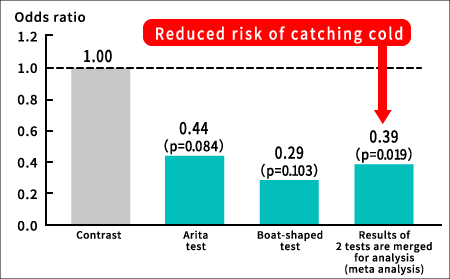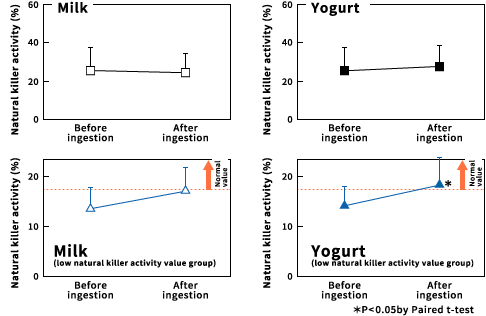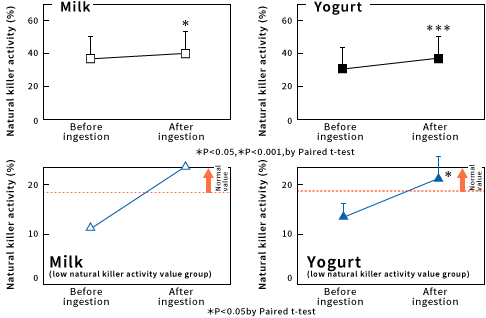|
Top page > Forefront of lactic acid bacteria research > Information on 1073R-1 lactic acid bacteria > Findings from 1073R-1 lactic acid bacteria research(1)
Findings from 1073R-1 lactic acid bacteria research(1)A human-subject study conducted in Yamagata and Saga prefectures indicates that consumption of yogurt containing 1073R-1 lactic acid bacteria reduces the risk of catching colds and increases NK activity.A study was conducted on 57 healthy seniors aged between 70 and 80 living in Funagatamachi, Yamagata Prefecture and 85 healthy seniors aged 60 and above living in Aritacho, Saga Prefecture to observe the effects of lactic acid bacteria on the immune system. Each of these regional subject pools was divided into two groups for the study. The first group was fed 90 g of yogurt containing 1073R-1 lactic acid bacteria per day, while the second group was fed 100 ml of milk per day. The subjects in Funagatamachi and Aritacho were kept on this dietary regimen for eight and 12 weeks, respectively, to compare the changes in physical condition and immunity between the groups. For both regions, the group that was fed yogurt containing 1073R-1 lactic acid bacteria had a significant*1 increase in the ability to produce T cells that tends to decline with age. In addition, the group that ingested yogurt containing 1073R-1 lactic acid bacteria showed a significant increase in NK activity for the subjects that had low NK activity levels pre-ingestion, in both regions. It was also observed that the subjects ingesting the yogurt were able to reduce the risk of infection with colds. If the risk for the milk-drinking groups was 1, the groups that ingested yogurt containing 1073R-1 lactic acid bacteria in Aritacho and Funagatamachi showed risks of 0.44 and 0.29, respectively, and a weighted average risk of 0.39 between the two regions, which is a large risk reduction. *This means that the experiment was statistically proven to be effective. As it is common to apply p<0.05 as the level of significance (i.e., less than 5% chance of sampling data 100 times and finding different results), this level was used in this study. A human-subject study verifies the efficacy of 1073R-1 lactic acid bacteria in reducing the risk of cold infectionIngestion of yogurt containing 1073R-1 lactic acid bacteria reduced the risk of cold infection and improved NK activity!
Result of the study conducted on NK activity in Funagatamachi, Yamagata Prefecture
Result of the study conducted on NK activity in Aritacho, Saga Prefecture
(Source: Makino S, et al., Br J Nutri: 104, 998-1006, 2010.) |
||||||||||||||||||||||||||||||||||||






